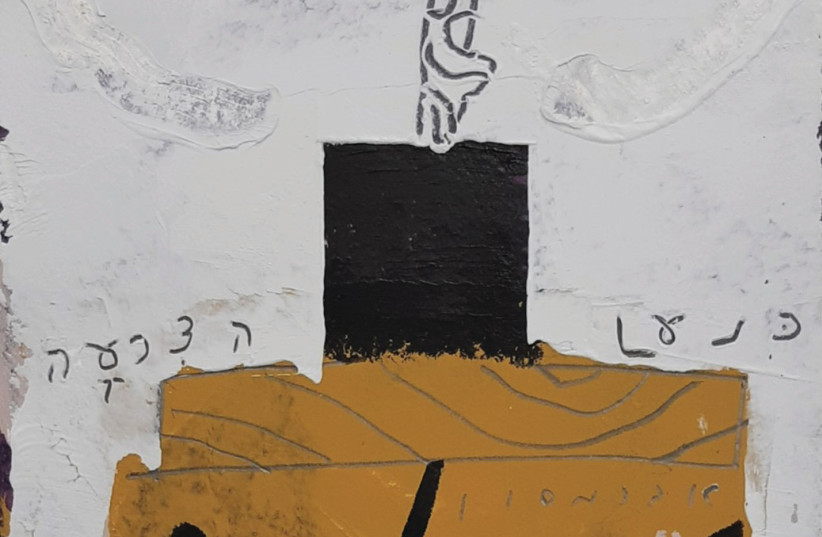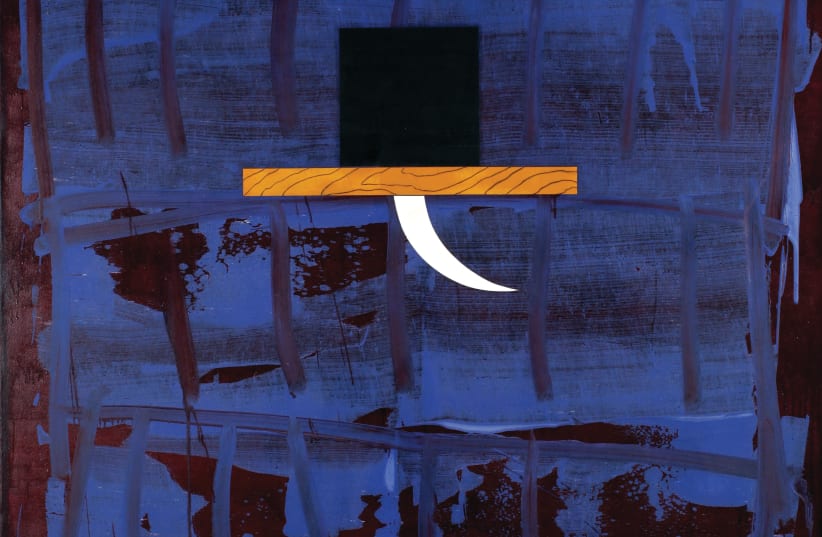About 100 people came to meet Larry Abramson and see the paintings now displayed in Signs, a new exhibition at the Kiryat Tivon Memorial Center Gallery for Israeli Art.
The Monday encounter included a discussion with curator Michal Shachnai Yaccobi, which drew so much attention that extra chairs had to be sought to host the crowd.
“A memorial center is about remembering, not forgetting,” Abramson told The Jerusalem Post. “A lot of my work is about the artist as a witness, or a spy.”
In paintings such as the 2010 Canaan – Hatsira or Gafno I, Abramson invokes the powerful connection between the Bible and the Land of Israel. “Hatsira” refers to the hornets sent by god to drive out the Canaanites (Exodus 23:28), the second work to the spies sent by Moses to tour the land of Canaan (Numbers 13:23) who returned with tales of “children of the giant” residing there.
Unlike Ephraim Moses Lilien, who depicted the scouts returning with one enormous bushel, Abramson painted plain grapes. His Rose of Jericho series is an almost botanical depiction of the unique resurrection plant, very unlike the 1903 cover of Ost und West by Lilien, with its Hebrew maiden holding the desert flower as if in rapture due to its ability to die, and return to life when conditions allow it – making it a powerful Zionist symbol of the return of the Jews to their ancient homeland.


Abramson, a mostly self-taught erudite artist, sought the company of working painters when he began considering the vocation of an artist in the 1970s. At the time, he befriended Michael Gross, who had a “definitive formal language which appealed to me,” he said. “Yet we disagreed on the ideology behind the painting.”
When Abramson read Martin Jay’s 1988 article “Scopic Regimes of Modernity,” he began to reflect on the following question: How did Zionist painters visually arrange the land they saw with their own eyes when they began working? What principles did they employ? Lilien, after all, left this land in 1907, one year after he co-founded the Bezalel Academy of Arts and Design.
His search led him to a remarkable insight. Joseph Zaritsky, the founder of the 1940s art movement New Horizons (“Ofakim Hadashim”) and the painter of the Tzuba 1970s watercolor series became a father figure to both learn from and grapple with.
“Lyrical abstraction,” Abramson says, “is the ultimate scopic regime of Zionism.
“It enables us to be both ‘Democratic and Jewish’: the democratic part means universal progressive values as manifest in abstract art,” he pointed out. “Yet the Jewish end of the equation means – use abstraction to deny Palestinian presence on the ground.”
In his own Tzuba series, Abramson painted the ruins of the Palestinian village near Jerusalem. “The ruin,” he wrote two decades ago in the Hurban book, “is utopia and destruction in one object.”
In 1995, when he presented Tzuba and discussed the Nakba (catastrophe), which is the previously undealt with Palestinian perspective of the 1948 war, any encounter with an audience meant hearing “angry voices,” he said.
This, perhaps, is one of the astounding things in Signs. Into a hall designed to remember those who had fallen defending this country, a painter had been invited and an audience came to greet him and hear his ideas with warmth.
“I believe I make paintings here in the studio,” Abramson said. “It becomes art only when people come see it. Art is a social event; the viewers are critical.”
For Shachnai Yaccobi, this is fitting with the wishes of funding families of the memorial center. “They wanted a living memorial center,” she said. “Not a space to visit once a year.”
In the hexagon at the center of the building that Yehiel Arad designed in 1987, books with the names of the fallen are open. The walls that encompass the site display the 1984 Nevo paintings, a powerful exploration of what it means to see the Promised Land and not be allowed entry. Kazimir Malevich’s Black Square, which symbolizes the alleged “death of painting,” floats in Abramson’s 1989 work How Beautiful the Nights XX and returns in 1967 (Maariv) where it serves as an altar to a cracked skull.
Collected by his father, epidemiologist Joe Abramson, the newspapers from the days leading up to and including the 1967 Six-Day War were used as painting surfaces a decade ago. For an Israeli eye, the result is spectacular.
Drawings of burnt Jordanian tanks made by Dani Karavan are in juxtaposition to cracked skulls. White brush-strokes allow the viewer to read the boasts of Moshe Dayan of how Israel is “waiting for the Arabs to phone” us underneath the paint. Ascot cigarettes, a now defunct brand, are advertised alongside obituaries of fallen soldiers. These 28 paintings, which take up an entire wall, are as powerful as a punch to the chest.
In the mid-1980s, Abramson took the New York subway when he spotted an ad for an exhibition at the Jewish Museum. At the time, he explained, he made a cultural choice to skip seeing works by a Jewish artist murdered in the Holocaust and instead spent his time absorbing contemporary American art. The painter was Felix Nussbaum.
Nussbaum would become another father figure for Abramson, who would go on to create his series of Piles paintings, not included in this exhibition, based on a 1944 work by Nussbaum titled The Triumph of Death.
A 2017 installation by his student, Michal Halpman, titled When Tyrants Rage was created in reference to the kites in the original painting and, I suggest, is even more alarming today as we watch news from the Russian-Ukrainian war.
“Nussbaum is almost the art world’s version of Anne Frank,” Chief Curator of the Haifa Museum of Art Dr. Kobi Ben-Meir suggested. Noting that it is not a coincidence Abramson first learned of him in the context of an exhibition in a Jewish museum, not an art museum.
“In his paintings,” Ben-Meir offered, “he shows what it felt like, and looked like, to be a persecuted Jew in the late 1930s and 1940s.”
Abramson, who suggests Charlotte Salomon is perhaps a better candidate for such a comparison, points to how Canaanism was never embraced by the public, neither were social-realist artists like Gershon Knispel, while Lyrical Abstract art was loved by nearly all and could be seen at the homes of most Israelis at the time.
Returning to the hornets, I asked Shachnai Yaccobi if insects are really what the Bible referred to and not leprosy (“tzara’at”).
“The signs here,” she offered, “are open [for interpretation].”
Signs at the Gallery for Israeli Art at the Kiryat Tivon Memorial Center will be on display until April 9. Admission is Free. (04) 9835506.
